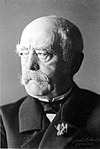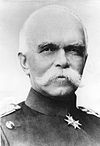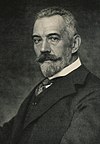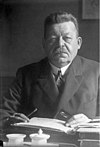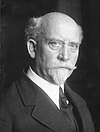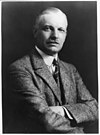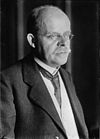Chancellor of Germany (TNO:ANM)
Jump to navigation
Jump to search
| Chancellor of the Reich | |
|---|---|
| Reichskanzler (German) | |
Standard of the chancellor | |
| Reich Government | |
| Style | Mr. Chancellor (informal) His Excellency (diplomatic) |
| Type | Head of government |
| Appointer | President of Germany |
| Term length | 4 years, renewable |
| Constituting instrument | German constitution |
| Inaugural holder | Otto von Bismarck |
| Formation | 21 March 1871 |
| Salary | ℛ︁ℳ︁400,000 |
| reichskanzlei.de | |
The chancellor of Germany, officially the chancellor of the Reich, (German: Reichskanzler) is the head of government of Germany.
Germany has a semi-presidential system in which the executive branch is divided between the Reich President and the Reich Government, with the chancellor heading the Reich Government. The chancellor is responsible for determining policies and guidelines, and determines whether or not the management of the Reich ministries comply with these policies and or guidelines.
List of officeholders
† denotes people who died in office.
North German Confederation (1867-1871)
| Portrait | Bundeskanzler | Took office | Left office | Time in office | Party | |
|---|---|---|---|---|---|---|
| Otto von Bismarck (1815–1898) | 1 July 1867 | 21 March 1871 | 3 years, 263 days | Non partisan | ||
German Empire (1871-1918)
| Portrait | Reichskanzler | Took office | Left office | Time in office | Party | Cabinet | |
|---|---|---|---|---|---|---|---|
| Otto von Bismarck (1815–1898) | 21 March 1871 | 20 March 1890 | 18 years, 364 days | Non partisan | Bismarck | ||
| Leo von Caprivi (1831–1899) | 20 March 1890 | 26 October 1894 | 4 years, 220 days | Non partisan | Caprivi | ||
| Chlodwig zu Hohenlohe-Schillingsfürst (1819–1901) | 29 October 1894 | 17 October 1900 | 5 years, 353 days | Non partisan | Hohenlohe-Schillingsfürst | ||
| Bernhard von Bülow (1849–1929) | 17 October 1900 | 14 July 1909 | 8 years, 270 days | Non partisan | Bülow | ||
| Theobald von Bethmann Hollweg (1856–1921) | 14 July 1909 | 13 July 1917 | 7 years, 364 days | Non partisan | Bethmann Hollweg | ||
| Georg Michaelis (1857–1936) | 14 July 1917 | 1 November 1917 | 111 days | Non partisan | Michaelis cabinet | ||
| Georg von Hertling (1843–1919) | 1 November 1917 | 30 September 1918 | 333 days | Centre | Hertling | ||
| Max von Baden (1867–1929) | 3 October 1918 | 9 November 1918 | 37 days | Non partisan | Baden | ||
Weimar Republic (1918-1933)
| Portrait | Reichskanzler | Took office | Left office | Time in office | Party | Cabinet | |
|---|---|---|---|---|---|---|---|
| Friedrich Ebert (1871–1925) | 9 November 1918 | 13 February 1919 | 96 days | SPD | Council of the People's Deputies SPD–USPD (as of 29 December 1918 SPD alone) | ||
| Philipp Scheidemann (1865–1939) | 13 February 1919 | 20 June 1919 | 127 days | SPD | Scheidemann SPD–DDP–Z (Weimar Coalition) | ||
| Gustav Bauer (1870–1944) | 21 June 1919 | 26 March 1920 | 279 days | SPD | Bauer SPD–DDP–Z (Weimar Coalition) | ||
| Hermann Müller (1876–1931) | 27 March 1920 | 21 June 1920 | 86 days | SPD | Müller I SPD–DDP–Z (Weimar Coalition) | ||
| Constantin Fehrenbach (1852–1926) | 25 June 1920 | 10 May 1921 | 319 days | Centre | Fehrenbach Z–DDP–DVP | ||
| Joseph Wirth (1879–1956) | 10 May 1921 | 22 November 1922 | 1 year, 196 days | Centre | Wirth I Z–SPD–DDP (Weimar Coalition) Wirth II Z–SPD–DDP (Weimar Coalition) | ||
| Wilhelm Cuno (1876–1933) | 22 November 1922 | 12 August 1923 | 263 days | Non partisan | Cuno Ind.–DVP–DDP–Z–BVP | ||
| Gustav Stresemann (1878–1929) | 13 August 1923 | 30 November 1923 | 109 days | DVP | Stresemann I DVP–SPD–Z–DDP Stresemann II DVP–SPD–Z–DDP | ||
| Wilhelm Marx (1863–1946) | 30 November 1923 | 15 January 1925 | 1 year, 46 days | Centre | Marx I Z–DVP–BVP–DDP Marx II Z–DVP–DDP | ||
| Hans Luther (1879–1962) | 15 January 1925 | 12 May 1926 | 1 year, 117 days | Non partisan | Luther I DVP–DNVP–Z–DDP–BVP Luther II DVP–Z–DDP–BVP | ||
| Wilhelm Marx (1863–1946) | 17 May 1926 | 28 June 1928 | 2 years, 42 days | Centre | Marx III Z–DVP–DDP–BVP Marx IV Z–DNVP–DVP–BVP | ||
| Hermann Müller (1876–1931) | 28 June 1928 | 27 March 1930 | 1 year, 272 days | SPD | Müller II SPD–DVP–DDP–Z–BVP | ||
| Heinrich Brüning (1885–1970) | 30 March 1930 | 30 May 1932 | 2 years, 61 days | Centre | Brüning I Z–DDP–DVP–WF–BVP–KVP Brüning II Z–DSP–BVP–KVP–CLV | ||
| Franz von Papen (1879–1969) | 1 June 1932 | 3 December 1932 | 185 days | Non partisan | Papen I Ind.–DNVP | ||
| Kurt von Schleicher (1882–1934) | 3 December 1932 | 30 January 1933 | 58 days | Non partisan | Schleicher I Ind.–DNVP | ||
| Adolf Hitler (1889–1963) | 30 January 1933 | 24 March 1933 | 53 days | NSDAP | Hitler NSDAP–DNVP | ||
Nazi Germany (1933-1976)
| Portrait | Reichskanzler | Took office | Left office | Time in office | Party | Cabinet | |
|---|---|---|---|---|---|---|---|
| Adolf Hitler (1889–1963) from 1934 Führer und Reichskanzler | 24 March 1933 | 15 October 1963 | 30 years, 205 days | NSDAP | Hitler NSDAP | ||
| Albert Speer (1905–1980) Recognized as Führer and Chancellor 23 March 1964 | 23 March 1964 | 3 April 1976 | 12 years, 11 days | NSDAP | Speer NSDAP | ||
German Reich (1976 - )
| Portrait | Reichskanzler | Took office | Left office | Time in office | Party | Election | Cabinet | |
|---|---|---|---|---|---|---|---|---|

